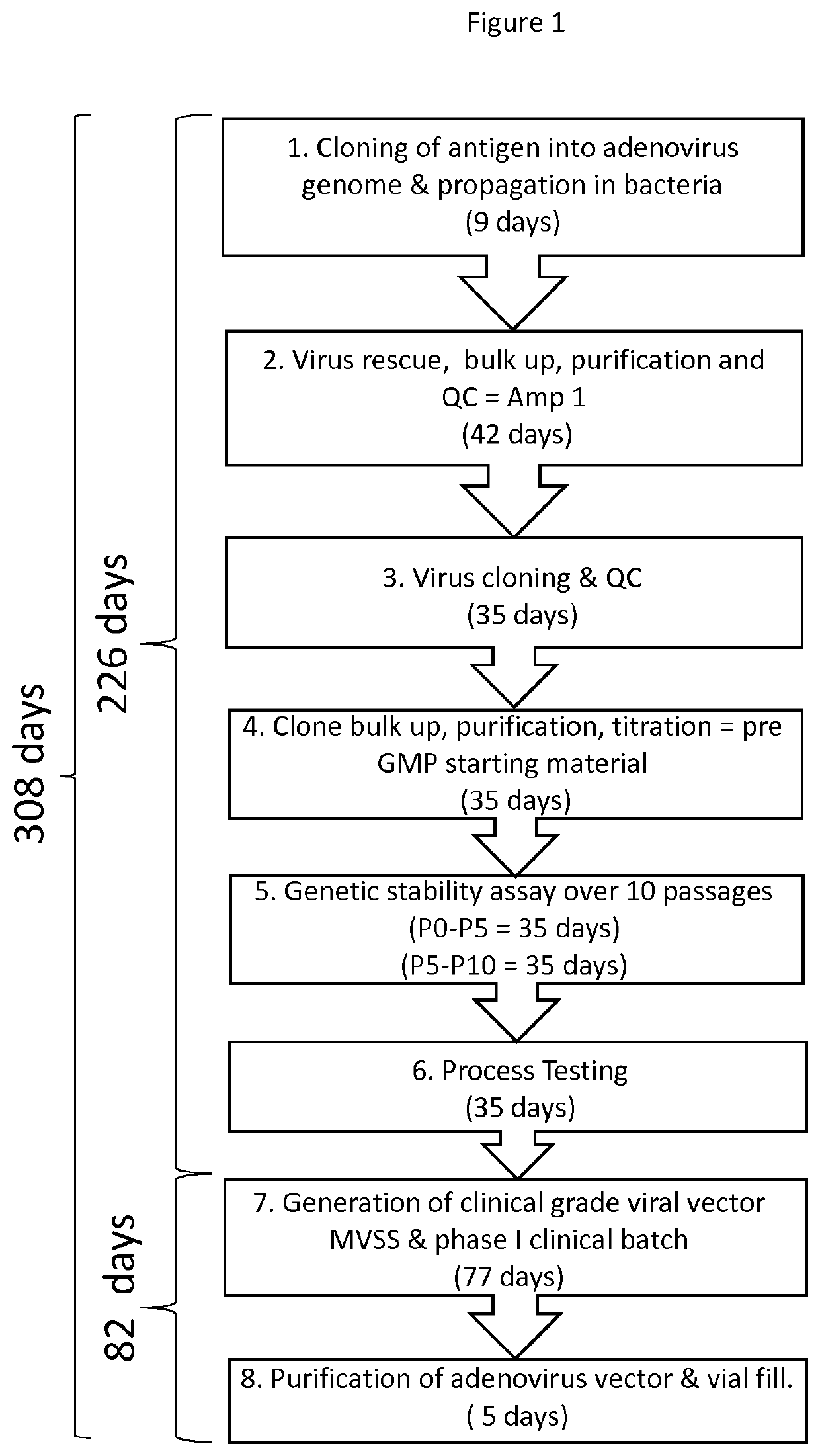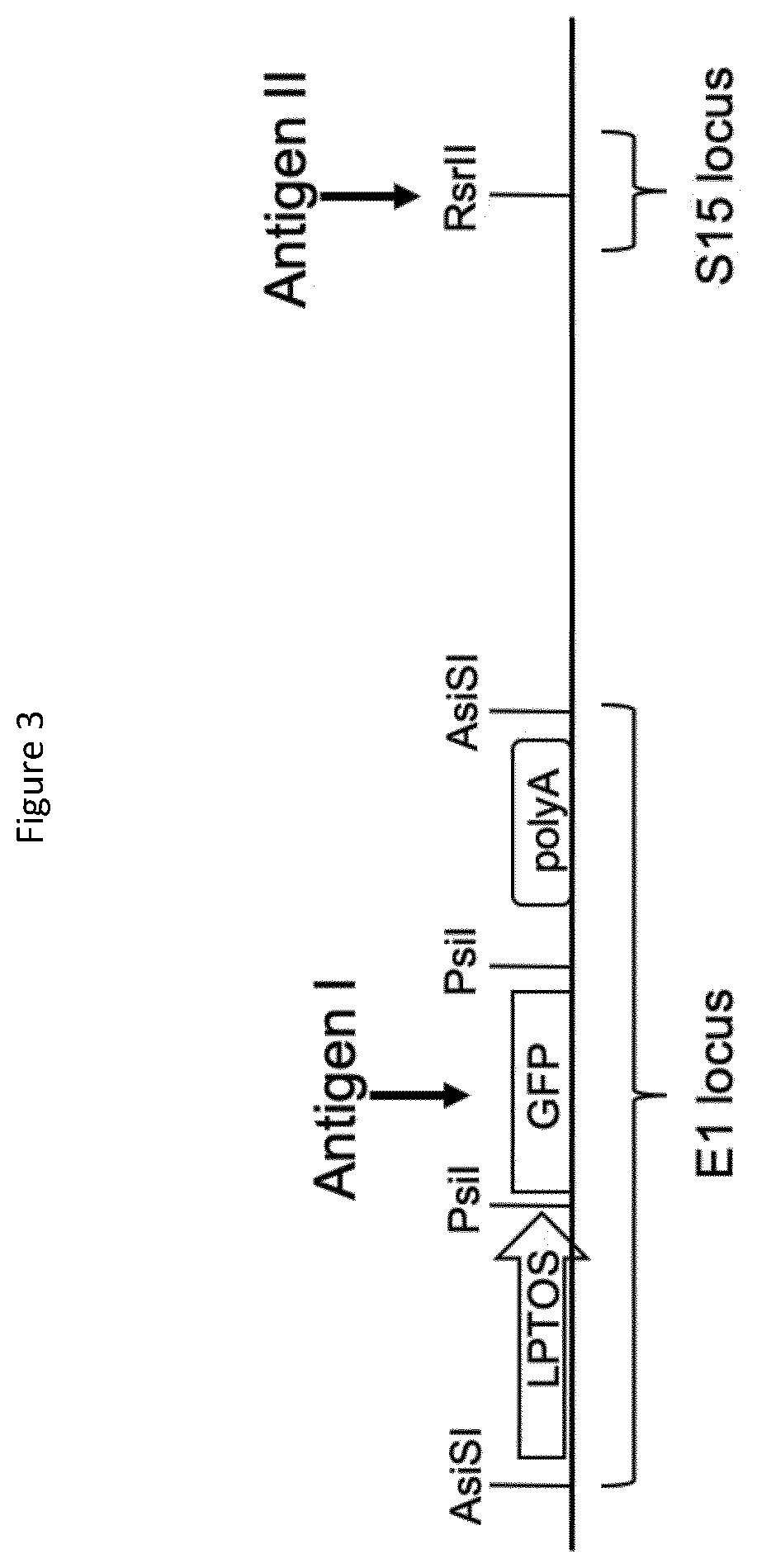Methods and compositions for producing a virus
- Summary
- Abstract
- Description
- Claims
- Application Information
AI Technical Summary
Benefits of technology
Problems solved by technology
Method used
Image
Examples
example 1
ion of Adenoviral Terminal Protein Complex Viral gDNA (TBC-gDNA) by Caesium Chloride Density Gradient Ultracentrifugation
[0062]A 55 kDa terminal protein (TP) is covalently linked to the 5′ end of each strand of adenoviral genomic DNA to produce terminal protein complex viral gDNA (TPC-Ad gDNA). Both serotype matched (“autologous”) and mis-matched (“heterologous”) TPs may be used in the invention. The TP protects the viral gDNA from digestion by cellular exonucleases and acts as a primer for the initiation of DNA replication and forms a heterodimer with DNA polymerase. The TP enhances replication by increasing template activity over 20 fold compared to protein-free templates through subtle changes in the origin of replication allowing binding of other replication factors. The TPC-Ad gDNA is isolated from disrupted purified virus particles using guanidine hydrochloride and purified by caesium chloride density gradient ultracentrifugation.
[0063]Purified virus solution containing betwee...
example 2
on of TPC-Ad gDNA for Recombination by Digestion with Unique Restriction Enzymes
[0067]The parental adenoviral genome, for example ChAdOx1-Bi-GFP as shown in FIG. 3, contains the GFP coding sequence at E1 flanked by the long tetracycline-regulated CMV promoter (LPTOS) and Bovine Growth Hormone (BGH) polyadenylation signal (poly A). The GFP ORF is flanked by a pair of unique restriction sites recognized by the PsiI restriction endonuclease and can be excised using PsiI resulting in the generation of 3 fragments: the left arm of the adenoviral genome, the GFP ORF and the right arm of the adenoviral genome. This parental virus can also be digested with AsiSI to excise the complete GFP expression cassette including the LPTOS and poly A. This parental virus can also be digested Rsrll to prepare the gDNA for insertion of an expression cassette at the S14 (E4) locus.
[0068]120 ng TPC-Ad gDNA was incubated overnight in an incubator at 37° C. with 10U PsiI in the recommended reaction buffer di...
example 4
ation of Adenovirus Genome Copy Number by QPCR from Cell Lysate or Purified Virus
[0076]Quantification of ChAdOx1, ChAdOx2 or ChAd63 viral genomes in HEK293 or T-Rex-293 cell lysates is measured by QPCR. The number of viral genomes (which can be related to viral particles on a 1:1 basis) is determined by quantitative PCR (qPCR) from cell lysates processed with DNAReleasy. A set of primers and a probe have been designed that bind to the left end of the genome downstream of the inverted terminal repeat (ITR) and upstream of the antigen insertion region in a non-coding region (see FIGS. 7A and 7B). These primers and probe sequences are:
PrimersChAd fwd(SEQ ID NO: 1)5′GTGGGAAAAGTGACGTCAAACGAG3′ChAd rev(SEQ ID NO: 2)5′TGCATCCGCCTAGAAACACCTCA3′ProbeChAd universal probe(SEQ ID NO: 3)5′GAGAGCGCGGGAAAATTGAGTATT3′
[0077]There is a single mismatch in the reverse primer in ChAdOx2; the sequence of the relevant regions in AdCh63 is identical to that in ChAdOx2 so this method may also be successful ...
PUM
| Property | Measurement | Unit |
|---|---|---|
| Fraction | aaaaa | aaaaa |
| Time | aaaaa | aaaaa |
| Mass | aaaaa | aaaaa |
Abstract
Description
Claims
Application Information
 Login to View More
Login to View More - R&D
- Intellectual Property
- Life Sciences
- Materials
- Tech Scout
- Unparalleled Data Quality
- Higher Quality Content
- 60% Fewer Hallucinations
Browse by: Latest US Patents, China's latest patents, Technical Efficacy Thesaurus, Application Domain, Technology Topic, Popular Technical Reports.
© 2025 PatSnap. All rights reserved.Legal|Privacy policy|Modern Slavery Act Transparency Statement|Sitemap|About US| Contact US: help@patsnap.com



